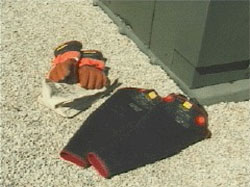Electric Power Generation, Transmission, and Distribution eTool
Personal Protective Equipment (PPE) » Insulating Gloves and Sleeves

Insulating gloves and sleeves are critical PPE for electrical work on or near exposed energized parts. The "269" standard (1910.269(l)(2)(i) and (l)(3)) requires that:
-
Insulating (rubber) gloves along with leather protectors must be worn by 269-qualified employees within the Minimum Approach Distance to exposed energized conductors.
-
Insulating (rubber) sleeves must also be worn if the upper arms or shoulders are within the Minimum Approach Distance to other exposed energized parts.
Additionally, 1910.137 provides specific design, care, and use requirements for rubber electrical protective equipment. Insulating gloves and sleeves must be rated for the voltage to which a worker will be exposed (phase to ground or phase to phase) and marked to indicate their rating. 1910.137 recognizes Class 0 (up to 1KV) through Class 4 (up to 36KV) rubber equipment. [See Mr. Edwin Hill Interpretation Letter (September 27, 2005)].
See: 1910.269(l)(2)(i) and 1910.269(l)(3) on insulating gloves and sleeves
Also see: 1910.137 on rubber insulating equipment
Testing and Inspection. Gloves and sleeves must be electrically tested before being issued for use. They must also be visually inspected and gloves need to be air tested for any possible defects (for example, cuts, holes, tears, embedded objects, changes in texture) before each day's use and whenever there is a reason to believe they may have been damaged. Best practice is to inspect PPE and air test the gloves and sleeves before each use. [See 1910.137(b)(2)].
-
Insulating equipment may not be used if any of the following defects are present: holes, tears, punctures or cuts, ozone cutting or ozone checking, embedded foreign objects, texture changes, including swelling, softening, hardening, or becoming sticky or inelastic, and any other defect that damages the insulating properties. [See 1910.137(c)(2)(ii) and ASTM F1236-96, Standard Guide for Visual Inspection of Electrical Protective Rubber Products].
-
Insulating equipment failing to pass inspection must be removed from service and may not be used by workers.

In addition, the gloves and sleeves must be electrically tested at regular intervals of not more than 6 months for gloves and 12 months for sleeves. (See ASTM F496, Standard Specification for In-Service Care of Insulating Gloves and Sleeves for some appropriate test methods.) When gloves and sleeves are used regularly, best practice is to test as frequently as monthly. [See 1910.137(b)(2)].
Protector Gloves and Storage. To ensure worker safety and the integrity of the gloves and sleeves, insulating gloves need to be worn along with protector gloves (such as leather), and both insulating gloves and sleeves need to be stored properly when not in use. Proper storage means that gloves must not be folded and need to be kept out of excessive heat, sunlight, humidity, ozone, and any chemical or substance that could damage the rubber. [See 1910.137(b)(2)].
For additional information on the use of insulating gloves and sleeves, see ASTM F496, Standard Specification for In-Service Care of Insulating Gloves and Sleeves, and ASTM F1236-96, Standard Guide for Visual Inspection of Electrical Protective Rubber Products. Additionally, see 1910.137(b)(2).
§ 1910.269
The proposed rule recognizes Class 0 and 00 gloves. See the proposed rule for additional information.
Personal Protective Equipment (PPE)
Donning and Doffing
Minimum Approach Distances

